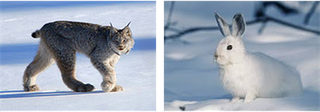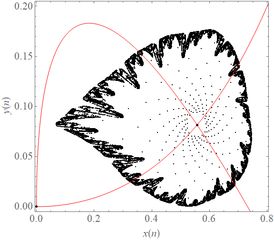Student Research Projects
Student Research Projects
Unraveling the Linx-Hare Paradox
Project Description. The Hudson Bay Company's pelt trading records of the Canadian lynx and snowshoe hare is possibly the best know data set in ecology. Over 100 years of data is available which dates back to the early 19th century. Using pelts as a proxy for the population density, textbooks on ecology or mathematical biology frequently present the Lotka-Volterra equations as a simple predator-prey model for this famous data set. The model exhibits limit cycle behavior; however, it suggests that hare eat lynx! Students working on this project are developing a mathematical population model to explain this apparent paradox. In addition to the lynx and hare populations, students will examine a model which includes a lower trophic level (vegetation) upon which the hare feed. A fourth predator population population, which preferentially targets the lynx, will also be considered.

Chaos in an Economic Model for Duopoly Pricing

Unraveling the Linx-Hare Paradox
Project Description. The Hudson Bay Company's pelt trading records of the Canadian lynx and snowshoe hare is possibly the best know data set in ecology. Over 100 years of data is available which dates back to the early 19th century. Using pelts as a proxy for the population density, textbooks on ecology or mathematical biology frequently present the Lotka-Volterra equations as a simple predator-prey model for this famous data set. The model exhibits limit cycle behavior; however, it suggests that hare eat lynx! Students working on this project are developing a mathematical population model to explain this apparent paradox. In addition to the lynx and hare populations, students will examine a model which includes a lower trophic level (vegetation) upon which the hare feed. A fourth predator population population, which preferentially targets the lynx, will also be considered.

Chaos in an Economic Model for Duopoly Pricing
